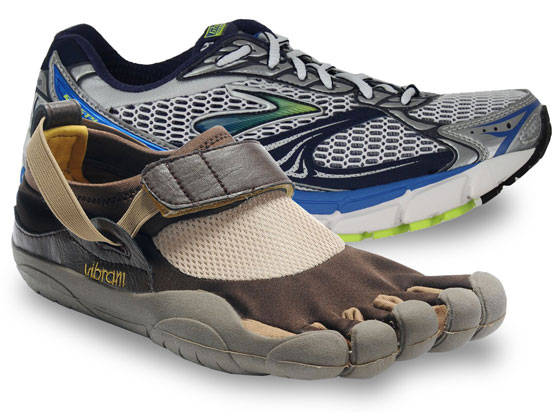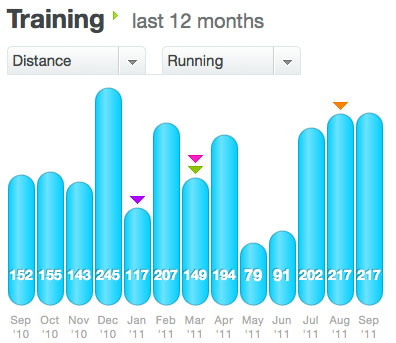
 Last year I started training in more minimal shoes and shoes with lower heel to toe drop. I had run in Saucony Kinvaras, Saucony Fastwitch 4 and 5, New Balance MT 101, Pearl Izumi Streak II, Saucony Mirage, Saucony Shadow Genesis, Saucony Type A4, Saucony Hattori, Brooks ST-5 to name a few. After running a PR marathon in January, followed up by a great Ragnar in February, and a good showing at the HAT 50k in March, I was sold on minimal shoes. They are so much lighter, that at the end of long runs I still feel a spring in my step.
Last year I started training in more minimal shoes and shoes with lower heel to toe drop. I had run in Saucony Kinvaras, Saucony Fastwitch 4 and 5, New Balance MT 101, Pearl Izumi Streak II, Saucony Mirage, Saucony Shadow Genesis, Saucony Type A4, Saucony Hattori, Brooks ST-5 to name a few. After running a PR marathon in January, followed up by a great Ragnar in February, and a good showing at the HAT 50k in March, I was sold on minimal shoes. They are so much lighter, that at the end of long runs I still feel a spring in my step.
Then April came. During some striders at the end of a recovery run, my calves started to tighten severely. I didn’t listen to them and before I knew it… POW! My right calf locked up and wouldn’t release. It was excruciating. I thought someone had shot me in the calf with a rifle. I ended up going to a massage therapist for two months and scaling my runs down to slow minimal miles if any at all. Biking became my refuge.
The time off and the message seemed to get me back in a good place. My mileage was getting back to normal. I continued wearing the more minimal footwear. Things went well through the summer.

About a week and half ago I started to feel tight calves again. I got out the stick and the foam roller and things felt tight but all right. Then I went for a 20-mile training run in the Saucony Fastwitch 5. When I finished up my calves were screaming! A day later I did my recovery run and I felt the familiar tightening that happened before. I stopped running immediately this time. A thought occurred to me, last year when I was training for the GORE-TEX® TransRockies Run I trained in Brooks Ghosts. I stayed injury free that whole training cycle and I was putting in the miles. I decided I would go get a pair of Brooks Ghost 4s at lunch. When I tried running in the store I felt no stress on my calf. The very same calf that earlier that same day was ready to blow. Even though the Brooks have an elevated heel to toe ratio (about 12mm) I still manage to strike midfoot in them. So, I don’t think that a change in my stride occurs in the Brooks.
I ran in the Brooks that night and my calves felt fine. Did I find a magic bullet? Instantly my legs felt better. The only thing I can think of is that my calves needed a break. The slight difference in the heel drop gave them just enough support. I still did my Thursday track workout in the Saucony Type A4 (4mm drop) and was ok. I went back to using the Brooks for my long run. After 20 miles my legs felt fine. I have to admit at the end of my run those Ghost felt mighty heavy on my feet.

Now I am not giving up my minimal shoes, it just makes me think that maybe I need a mix in my shoe diet. While people are debating which is better and who is right in the great shoe battles that broke out after “Born to Run,” I am suggesting they can coexist. I also believe that running shoes are like glasses for vision. Not everyone needs them and those that do need them, need them in varying prescriptions. A person with 20/20 vision will tell you glasses are BS and only make your eyes worse. A person that can run well barefoot will tell you shoes are for dopes. If you need to wear glasses get a cool pair, if you need a traditional trainer run in them with pride. For me, minimal shoes are an “everything in moderation” kinda thing.
I am basing the previous thoughts on my observations alone. I trust Peter Larson (runblogger) to have the science behind my intuition. His thoughts validate my gut reaction to what is going on…
“Minimal shoes are absolutely going to work your calves more. The lower heel-forefoot drop means that the calves will stretch a bit more, and will be working at a little different point on their normal length-tension curve. Combine this with a midfoot-forefoot strike that triggers the stretch-shortening reflex on ground contact, and you see why a lot of people get calf soreness, at least initially, when switching into more minimal shoes. Furthermore, lower heeled shoes require greater eccentric work by the calves (contraction while the muscle is lenghtening), and eccentric muscle contraction is more likely to cause delayed onset muscle soreness.
I think you are right on in your approach – find the mix that works best for you. If mixing the Ghost in allows you to run pain free, I see absolutely no reason not to do it. You could also go for a lighter shoe with a traditional heel lift – maybe something like the Brooks T7 Racer or the NB MR1400. I don’t run all of my miles zero drop for the same reason – some days my calves need a break, and 4mm lift is about all I need to ease off a bit. Each individual is going to have a slightly different threshold determined by their anatomy, physiology, past, and present shoe wear. For example, if you spend all day in work shoes with a significant heel lift, ending the day with a run in minimal shoes may not be the best thing to do – your calf and Achilles adjust to the heel lift during the day, and taking it away abruptly can strain things. I now wear zero drop work shoes (Vivobarefoot Aqua) to avoid this issue. It may turn out that going minimal may require a more profound switch in footwear choices, as what you wear all day may be just as, if not more important than what you wear on an hour-long run.
As a tip – you can use a little foam heel wedge under the insole of a more minimal shoe to ease off the calf a bit – Newton is including one with the MV2. You could either cut your own out of a sheet of craft foam, or cut the heel off an old insole. Stick it under the insole of your minimal shoe and you can still reap the benefits of the lighter weight.”
Have something to say? Leave a Comment

Hey Thomas –
Great minimal shoe run down on your experience. I am using Bikila's and had similar calf issues the first month. After that, I haven't had calf issues. Recently, I have had 5th metatarsal issues in my right foot. I am still trying to transition without going back to shoes but may need to use VFF's for half of next weeks Denver marathon and shoes the second half.
Just found your site, but will definitely follow. Check out my latest experience and recovery with VFF's over at http://RunningSomewhere.com.
David Damron
Running Somewhere
Thanks David. Good luck with the Denver Marathon.
Interesting observations. In my own experience there are a ton of “growing pains” associated with going minimal. Over the course of about 2 years I went from wearing typical shoes to running comfortably minimal and even bare, but it wasn’t without pain/injury/setback. I think it takes a long time for the leg muscles, tendons and bones to become strong enough to handle the new strains and stresses associated with running more naturally. Like in your case Thomas, I’ve found that the lower leg and foot can suffer the most, because for all to long they have been weakened and coddled by traditional modern footwear. And when we push the limits of our fitness and train hard, these same areas are the ones affected first and hardest. Just think of it, if our lower legs are the weakest part of the machine, they are constantly playing catch up with the rest of our body. If they can’t adapt fast enough, they break. So once we start reaching greater fitness and training levels the lower leg/calf areas have to work even harder to maintain. And to me this opens up the door to injury or setbacks. I’ve learned the only way to avoid injury is to take it slow, enjoy rest and listen to your body. Allow your mechanics to adjust, your muscles to get stronger and any soreness to lessen is key. Employing your method is a good approach, I believe, in taking your transition slow. Don’t push too hard until you think you are at a good strength level (which in my case took over a year to get to a decent level, and included running barefoot and never wearing any footwear with “support” or any of those bogus shoe marketing terms) and as my fitness level increases I have to be cognizant of not pushing my lower legs to hard, after all, they are the most susceptible to injury. And we all know injury is very detrimental to having fun.
Great post.
-bobby g
I have had 4 different calf pulls from running in my VFF Bikilas, and doing to much to quickly. I actually have had to shelve them entirely until after the Marine Corps Marathon – but do plan on returning to them. I have come to the same conclusion as you have, that I need to mix them in slowly. On my blog, my posting about VFFs and calf pain is the most often viewed – do to folks googling that combination of terms.
I do still have a long-term goal of switching over to them entirely though.
I've actually had the opposite occur. I eased into minimal shoes just fine, first having one minimal and two non-minimal in my three-shoe rotation. When I moved to two minimal and only one non-minimal in my rotation, my calves only hurt when I run in the NON-MINIMAL shoes.
What exactly is a “message therapist”?
Ha ha, good catch.